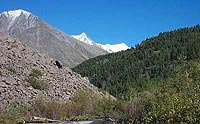Pearls of Russia
Museums and memorial estates
 Altai
Altai
"Golden mountains" (from Mongolian word "altan") - is one of the meanings of the word "Altai". Really there is gold here, although Altai was never included to the number of popular gold-fields, such as for example Eldorado or Kolyma. There exists one more interpretation of this word - "motley mountains". It reflects the general picture of the region more precisely.
Altai stretches from North-West to South-East for more than 2 thousand km. Having climbed a slope somewhere in the valley of the Tchui River one may see, that the slope directed northward is overgrown with thick grass, and the opposite slope languid with the heat is covered with dry steppe grasses, thorny bushes of acacia and barberries. When it is midsummer at the bottom of the valley where the white waters of the Tchui flow, at the crests of high ridges an early spring begins. Then one may actually agree that Altai is motley mountains.
Altai is so diverse, that it may satisfy the taste of any traveller.
It is possible to travel around Altai on foot and on ski, on horseback or on camelback, by helicopter or hand glider and paraglider, by light sporting boats on rapid mountain rivers and by comfortable motor ships on Lake Teletskoye which is also called Altyn Kyol (Golden Lake), on mountain skis upon steep slopes or by cars and bicycles across mountain passes searching for "the heart of Asia"-With the special alpinist equipment on icefalls and sheer rocks to transcendental tops of the highest Siberian mountains or in fathomless pits of the deepest caves, with aqualungs along the bottoms of transparent mountain lakes, with guns in taiga pursuing an expensive hunting trophy - it is really difficult to imagine any kind of tourism impossible in Altai.
European travellers, who happened to be here last century, found striking resemblance between Altai and the Switzerland Alps. That's why no wonder that such names as Siberian Switzerland, North-Tchuya Alps, the Katun Alps appeared. The Swisses, who recently visited Altai, prove this resemblance and say with unconcealed envy, that only here one may imagine the Alps as they were before tourist inroad. Today not large hotels and roads to them are being built in Altai.
The majority of geographical discoveries in Altai were made last century. However, nowadays lots of new is found here. So, only in the end of the 70-s the deepest caves were discovered and explored in the river-head of the Ustyuba and in Seminsky Ridge. Scientists think, that explorations of the Altaian karst will give not a single discovery. In the mid 70-s the waterfall on the Chulcha River gained great popularity. This biggest waterfall has the total fall height of 160 m and is a marvelous view.
Archeological finds of recent years attract attention of specialists all over the world: a site of a man in Denissov cave on the Anuya River is almost the oldest one in Asia. People living in these mountains, their way of life and history are a real fount for travellers, for Altai is a point of contiguity and inter-penetration of different religions: Christianity, Mohammedanism, Lamaism and Buddhism, and some Altaian tribes still preserve their pagan faith and live watched by a kind god Ulgen and malicious Erlic.
Altai is a wonderful example of how much t people's life depends on nature, is determined by land where they live. The same as many years ago people pasture cattle here, hunt for wild animals, weave homemade carpets. A great area of these mountains were not industrially developed, that's why food production gained mostly by means of old grandfather's methods is environmentally safe. Many products of natural origin possess unique medical properties, e.g. maral horns obtained in maral-breeding farms, honey and propolis from mountain apiaries, golden root.
|